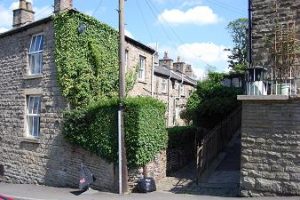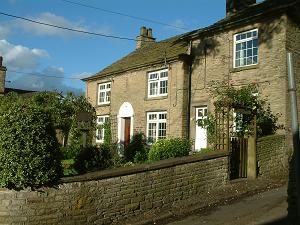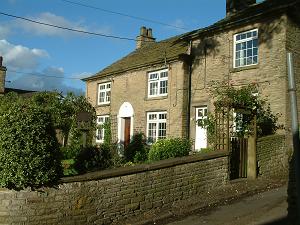(with Daisy Bank)
 |
One of the most delightful streets in Bollington, Lord Street wends its way up the hill from Church Street to Chancery Lane. The properties are all stone cottages with the very fine Adshead’s Farm House (pictured bottom left) at the top. There are several instances of the cottages being built sideways on to the street, accessed by ginnels. In one case the ginnel leads to a yard with a further row of cottages standing parallel to the street. This area was called Daisybank and included several cottages which were built on ‘The Little Lower Meadow’. Queensbench Building was only called this after 1861, before this time it was just Lord street. Queensbench Building was built by George Redfern from Derby who bought the land from Mary Broster, it was witnessed by Samuel Higginbotham solicitor. Wagstaff Lane is mentioned but it is not sure yet where that was. Queensbench Building is where the 19thC Assize Court Judge would have been put up for the night when he was attending court locally. There is a name stone on the side of the building. Many properties have fine views over the village and the surrounding countryside. As a consequence of this tightly packed housing, parking is a major problem on the street. The cottages on Daisybank have no vehicular access. There used to be at least two beer houses in the street, the Waddling Duck at numbers 10 and 12 near the bottom and the Rising Sun half way up the hill with the three big stone steps up to the door. Approach off Church Street, Chancery Lane. Leads to Allen Street, Cumberland Drive, Deanway (Bollin Heights, Mill Bank Court), Chancery Lane, Cow Lane. Nearest shops – Palmerston Street. Nearest pubs – Church House, Spinner’s Arms. Council Ward – West side, Central; east side, East. The steepest top section of the street was referred to as Adshead Barn Brow in the 1851 census. See the page on Brows. |
 |
|
 |
Conservation
Conservation: This street is in the Bollington & Kerridge Conservation Area. Numbers 2-54, 5-41 and 21A are subject to Article 4 Direction.
History
If the house was built before 1644 (see below) then there would have been very few other buildings in the valley and the view would have been quite outstanding with perhaps just a couple of other buildings to be seen.
 |
The top piece of Lord Street in front of the farm was referred to as Adshead Barn Brow in the 1851 census. The cottage to the right of the house was, in the mid 19thC, occupied by the Chatterton family. James Shepley Chatterton was known as the Milestone King because he wrote a poem for publication every birthday. See the page devoted to the family. The cottage is now integrated with the house. |
Jane Laughton, the local historian, has pointed out that in 1611 [the] Adshead [family] were operating Rainow Mill, then a corn mill, which had been leased to the family since 1549. She suggests that it was George Adshead, a farmer, dyer and carrier, who died in 1644, who built Adshead’s Barn on an outlying part of his holdings.
George Longden 2002.
(Extract from a history of Kerridge Hill and Ingersley Vale by George Longden for KRIV.)